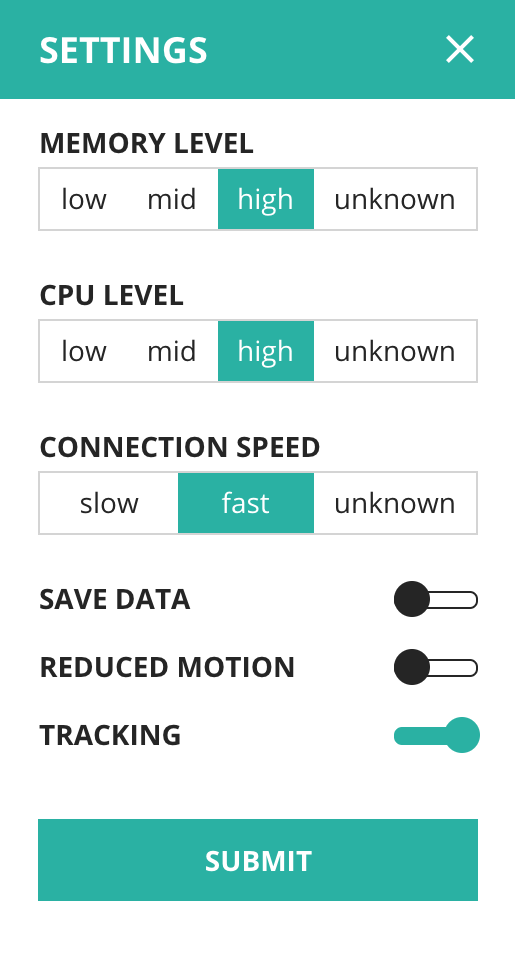Progressive User Experience Library (ProgUX) is designed to help developers make decisions on the end experience they deliver to the end users.
Once added to a web application an object will be added to the session storage and classes added to the HTML tag that will indicate:
- Users Preferences
- Prefers Reduced Motion
- Save Data Settings
- Tracking Settings
- Network
- Connection Speed
- Device Capabilities
- CPU Capacity
- Memory Level
Each of these can be used to decide what features, content, JavaScript, CSS, etc. will be delivered to the user to create a progressive user experience.
Idea is similar to one provided in react-adapitve-hooks, however ProgUX is not limited to React, adds to CSS and provides a small simulator
To start using ProgUX inline the code from dist/prod/bundle.js and call the progUX() to initialise the script.
If you want to override any of the configurations pass it to the function as an object.
<script type="application/javascript">
!function(){"use strict";const n=n=>"connection"in navigator ... // inline whole code
progUX({
sessionStorageKey: 'someOtherKeyName'
});
</script>
How your application changes and adapts to the environmental constraints and capabilities is ultimately up to you. ProgUX will not perform any magic that will change your application, it simply provides each developer who uses it a snapshot with which they can make decisions.
Ultimately how you use this is up-to-you, below we describe how you can gain access to this information.
Once installed and the application has reloaded developers will have access to an object in the session storage as well as a number of classes to reference in the <HTML> tag.
The object will contain the following keys and values:
connectionSpeed: String // 'slow/fast/unknown'
cpuLevel: String // 'low/mid/high/unknown'
memoryLevel: String // 'low/mid/high/unknown'
reducedMotion: Boolean
saveData: Boolean
tracking: BooleanThe <HTML> tag will contain the following classes
connectionSpeed-[slow/fast/unknown]
cpuLevel-[low/mid/high/unknown]
memoryLevel-[low/mid/high/unknown]
reducedMotion-[true/false]
saveData-[true/false]
tracking-[enabled/disabled]
The output will look similar to this
<html class="connectionSpeed-slow cpuLevel-low ...">
You then have access to the classes to make decisions in your code, for example
.connectionSpeed-slow {
.stage-image {
display: block;
}
.stage-video {
display: none;
}
}
To try to limit the impact of unnecessary JavaScript checks ProgUX will only update the connectionSpeed during a user session. This is simply because we believe that this is the only one of our checks likely to change during a session.
To aid development we have provided a dist/dev/dev-bundle.js and dist/dev/dev-bundle.css files that contain extra features.
Using this script will run the checks in exactly the same way as the production script but contains a modal that allows you to change the settings on the fly.
You can inline this script as well or use it as modules (JS). CSS you can add to your project and link to the stylesheet in the head.
Once your application has loaded you will see a cog icon (by default in the top left of your screen), if you click the icon it will open the settings modal.
The modal will automatically be set to reflect the current settings and to make adjustments to this you simply alter the controls to your new desired configuration and hit the 'Submit' button. This will force a page reload, the session storage object and the classes in the HTML will have been updated
Inside the modal there is also a toggle switch to show a 'Current Status' bar.
This is designed so that if you need to take screenshots of particular variations of the application it will be easy to identify the ProgUX settings at that time.
The Status Bar is moveable to provide you with the best result.
ProgUX provides a config.js file found in src/js.
Inside the file you will find an object with the following properties
// prod and dev
settings:
lowRAM: Number // 0.25, 0.5, 1, 2, 4, 8
lowCPU: Number // > 0
slowConnectionTypes: Array // 'slow-2g','2g','3g', or '4g'
sessionStorageKey: String // 'progressiveUserSettings',
// dev only
sessionStorageDevKey: String // 'progressiveUserDevSettings',
defaultDevSettings:
isDraggable: Boolean
mode: String // 'closed','open'
posTop: Number // 20 (in px)
posLeft: Number // 20 (in px)You can use this attribute names and structure when overriding wanted attributes.
Oveeride of the default congiguration is possible by passing the object with new values for wanted properties to init function (progUX() or progUXdev())
Overriding the values will set the thresholds tested by ProgUX in your application.
For instance, by default slowConnectionTypes is set to ['slow-2g', '2g', '3g'], if you considered '3g' to not be a slow connection you could remove it.
Overriding the sessionStorageKey will alter the name of the object saved in your session storage, etc.
Unfortunately, not all modern browsers support all the APIs, so please check support list before using and plan fallback.
-
Network Information API - saveData is available in Chrome 61+, Opera 48+, Edge 79+, Chrome for Android 76+, Firefox for Android 68+
-
Navigator API - doNotTrack is available in Chrome 23+, Firefox 32+, Opera 12.1+, Edge 17+, Chrome for Android 76+, Firefox for Android 68+
-
Prefers Reduced Motion Media Query is available in Chrome 74+, Firefox 63+, Safari 10.1+ Opera 12.1+, Edge 79+, Chrome for Android 76+, Firefox for Android 68+, iOS Safari 10.3+
-
Network Information API - effectiveType is available in Chrome 61+, Opera 48+, Edge 79+, Chrome for Android 76+, Firefox for Android 68+
-
Hardware Concurrency API is available in Chrome 37+, Safari 10.1+, Firefox 48+, Opera 24+, Edge 15+, Chrome for Android 76+, Safari on iOS 10.3+, Firefox for Android 68+, Opera for Android 46+
-
Device Memory API is available in Chrome 63+, Opera 50+, Edge 79+, Chrome for Android 76+, Opera for Android 46+
Pull requests are welcome. For major changes, please open an issue first to discuss what you would like to change.


